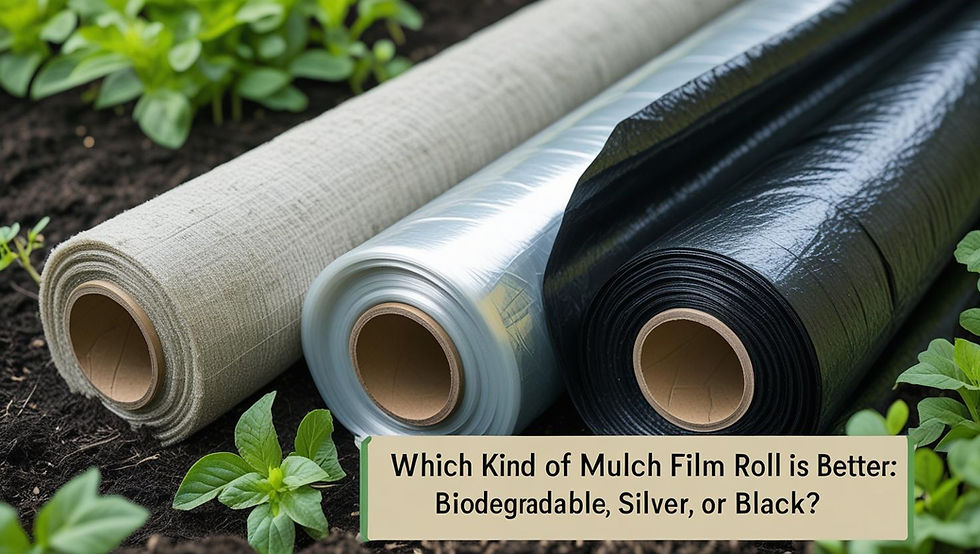Thermal Lamination Roll vs. Cold Lamination Roll – Key Differences
- Rahul Solanki
- Jul 8
- 4 min read

Selecting the appropriate lamination roll is essential for completing printed materials. Your packaging or printed output's appearance, durability, and cost can all be greatly impacted by your choice between thermal and cold lamination. The main distinctions between thermal and cold lamination roll options will be discussed in this article. The function of pharmaceutical-grade poly and the contributions of producers such as Tilak Poly Pack Pvt.Ltd in providing premium laminates for a range of industries will also be discussed.
The lamination roll is the unsung hero of the laminate industry. Knowing the differences between lamination technologies is essential to guaranteeing effectiveness and quality, regardless of whether you are working with pharmaceutical-grade poly or commercial prints. Although both kinds of lamination rolls protect and improve the substrate, their application methods, looks, and material compatibility vary.
What Is a Lamination Roll?
General Definition
A lamination roll is a roll of plastic film that is used to give different substrates, such as paper, cardboard, and flexible packaging films, a decorative and protective coating. These rolls come in a variety of film types, including PET, BOPP, and nylon, as well as finishes, such as gloss, matte, silk, and anti-scratch.
Why Lamination Matters
Lamination is more than a finishing touch; it is essential for:
Durability
Moisture resistance
Tear resistance
Improved visual appeal
This becomes even more vital in medical and food packaging, where pharma grade poly plays a pivotal role.
What is Thermal Lamination?
Application Process
A lamination roll that has been previously coated with an adhesive is used in thermal lamination. The film is bonded to the surface by the activation of the adhesive by heat and pressure. Usually, thermal laminating machines are used for this.
Key Features
Requires heat (80°C to 120°C)
Fast and strong adhesion
Smooth, professional finish
Ideal for bulk printing and packaging
Advantages
Time-efficient for large volumes
Durable and long-lasting
Commonly used in commercial print and packaging industries
What is Cold Lamination?
Application Process
However, heat is not necessary for cold lamination. Rather, a pressure-sensitive adhesive is applied to the lamination roll. The film is bonded to the substrate by applying pressure with rollers.
Key Features
No heat required
Suitable for heat-sensitive materials
Often used in signage and photographic applications
Advantages
Safe for delicate or temperature-sensitive media
Easier setup, especially for small runs
Reduced risk of substrate damage
Pharma Applications: The Role of Pharma Grade Poly
Why It Matters
Using the proper materials, such as pharma grade poly, in pharmaceutical packaging guarantees adherence to safety and health regulations. This poly film is intended to shield medications from contamination, moisture, and ultraviolet light.
Thermal vs. Cold Lamination in Pharma
Thermal lamination is ideal for large-scale pharma packaging where speed and strong adhesion matter.
Cold lamination may be used where substrates are sensitive, but it is less common in pharma applications.
One of the leading companies in the market, Tilak Poly Pack Pvt.Ltd., provides options for both cold and thermal lamination rolls that are especially tailored for pharmaceutical-grade poly and associated uses.
Tilak Poly pack Pvt.Ltd: Leading the Laminate Industry
Overview
In the laminates industry, Tilak Poly Pack Pvt. Ltd. is renowned for its dedication to quality and innovation. Their selection of lamination roll products serves the printing, pharmaceutical, and packaging industries.
Contributions to Pharma Grade Poly
They have developed specialty laminates that meet stringent pharma grade poly standards, ensuring:
Hygiene
Barrier properties
FDA compliance
Sustainability Focus
In keeping with international sustainability goals, Tilak Poly Pack Pvt.Ltd is also leading the way in environmentally friendly substitutes, such as recyclable and biodegradable laminates.
Comparing the Two: Thermal vs. Cold Lamination
When to Use Each
Choose thermal lamination for mass production with heat-resistant materials.
Opt for cold lamination for small-scale or heat-sensitive applications.
Choosing the Right Lamination Roll
Factors to Consider
Substrate type
Desired finish
Volume of work
Cost-effectiveness
Equipment compatibility
Where Pharma Grade Poly Fits In
To guarantee compliance and product integrity, always take into account laminates certified for pharma grade poly for sensitive packaging and pharmaceuticals.
Getting Expert Advice
To choose the ideal lamination roll for your requirements, consult with vendors such as Tilak Poly pack Pvt.Ltd.
FAQs
What is the main benefit of using a thermal lamination roll?
Strong adhesion and durability make it perfect for printing and packaging in large quantities.
Can pharma grade poly be used in cold lamination?
It's less common, though. Pharma-grade poly in thermal processes is better suited for heat-resistant films.
How does Tilak Poly pack Pvt.Ltd support pharma packaging?
They provide high-barrier laminates that are FDA-compliant and made for the safety and shelf life of pharmaceuticals.
Are there eco-friendly lamination roll options?
Yes. Some suppliers, including Tilak Poly pack Pvt.Ltd, offer recyclable or biodegradable film types.
Is there a universal lamination roll that suits all needs?
No. The choice depends on your specific use-case, material sensitivity, and scale of operation.
Conclusion
Choosing the appropriate finishing method requires an understanding of the distinctions between thermal and cold lamination roll options. Although both techniques have aesthetic and protective benefits, the best option will rely on the requirements of your product, particularly when using pharma-grade poly. To guarantee performance, compliance, and value, reputable manufacturers such as Tilak Poly pack Pvt.Ltd can assist in directing your selection process.



Comments